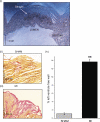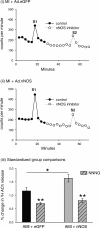Cardiac cholinergic NO-cGMP signaling following acute myocardial infarction and nNOS gene transfer
- PMID: 18621854
- PMCID: PMC2544496
- DOI: 10.1152/ajpheart.00492.2008
Cardiac cholinergic NO-cGMP signaling following acute myocardial infarction and nNOS gene transfer
Abstract
Myocardial infarction (MI) is associated with oxidative stress, which may cause cardiac autonomic impairment. We tested the hypothesis that acute MI disrupts cardiac cholinergic signaling by impairing nitric oxide (NO)-cGMP modulation of acetylcholine (ACh) release and whether the restoration of this pathway following cardiac neuronal NO synthase (nNOS) gene transfer had any bearing on the neural phenotype. Guinea pigs underwent four ligature coronary artery surgery (n = 50) under general anesthesia to induce MI or sham surgery (n = 32). In a separate group, at the time of MI surgery, adenovirus encoding nNOS (n = 29) or enhanced green fluorescent protein (eGFP; n = 30) was injected directly into the right atria, where the postganglionic cholinergic neurons reside. In vitro-evoked right atrial [3H]ACh release, right atrial NOS activity, and cGMP levels were measured at 3 days. Post-MI 24% of guinea pigs died compared with 9% in the sham-operated group. Evoked right atrial [3H]ACh release was significantly (P < 0.05) decreased in the MI group as was NOS activity and cGMP levels. Tetrahydrobiopterin levels were not significantly different between the sham and MI groups. Infarct sizes between gene-transferred groups were not significantly different. The nNOS transduced group had significantly increased right atrial [3H]ACh release, right atrial NOS activity, cGMP levels, and decreased cAMP levels. Fourteen percent of the nNOS transduced animals died compared with 31% mortality in the MI + eGFP group at 3 days. In conclusion, cardiac nNOS gene transfer partially restores the defective NO-cGMP cholinergic pathway post-MI, which was associated with a trend of improved survival at 3 days.
Figures







Similar articles
-
Gene transfer of neuronal nitric oxide synthase into intracardiac Ganglia reverses vagal impairment in hypertensive rats.Hypertension. 2007 Feb;49(2):380-8. doi: 10.1161/01.HYP.0000255792.97033.f7. Epub 2007 Jan 8. Hypertension. 2007. PMID: 17210833
-
Noradrenergic cell specific gene transfer with neuronal nitric oxide synthase reduces cardiac sympathetic neurotransmission in hypertensive rats.Hypertension. 2007 Jul;50(1):69-74. doi: 10.1161/HYPERTENSIONAHA.107.088591. Epub 2007 May 21. Hypertension. 2007. PMID: 17515453
-
Long-term effect of neuronal nitric oxide synthase over-expression on cardiac neurotransmission mediated by a lentiviral vector.J Physiol. 2009 Jul 15;587(Pt 14):3629-37. doi: 10.1113/jphysiol.2009.172866. Epub 2009 Jun 2. J Physiol. 2009. PMID: 19491240 Free PMC article.
-
NO-cGMP signaling and regenerative medicine involving stem cells.Neurochem Res. 2007 Apr-May;32(4-5):681-94. doi: 10.1007/s11064-006-9167-y. Epub 2006 Oct 18. Neurochem Res. 2007. PMID: 17043768 Review.
-
Traumatic injury of the spinal cord and nitric oxide.Prog Brain Res. 2007;161:171-83. doi: 10.1016/S0079-6123(06)61011-X. Prog Brain Res. 2007. PMID: 17618976 Review.
Cited by
-
The cardiac sympathetic co-transmitter galanin reduces acetylcholine release and vagal bradycardia: implications for neural control of cardiac excitability.J Mol Cell Cardiol. 2012 Mar;52(3):667-76. doi: 10.1016/j.yjmcc.2011.11.016. Epub 2011 Dec 7. J Mol Cell Cardiol. 2012. PMID: 22172449 Free PMC article.
-
Further investigations on the influence of protein phosphatases on the signaling of muscarinic receptors in the atria of mouse hearts.Naunyn Schmiedebergs Arch Pharmacol. 2024 Aug;397(8):5731-5743. doi: 10.1007/s00210-024-02973-4. Epub 2024 Feb 3. Naunyn Schmiedebergs Arch Pharmacol. 2024. PMID: 38308688 Free PMC article.
-
Cardiac Sympathetic Denervation in Channelopathies.Front Cardiovasc Med. 2019 Mar 26;6:27. doi: 10.3389/fcvm.2019.00027. eCollection 2019. Front Cardiovasc Med. 2019. PMID: 30972341 Free PMC article. Review.
-
Cardiac sympatho-vagal balance and ventricular arrhythmia.Auton Neurosci. 2016 Aug;199:29-37. doi: 10.1016/j.autneu.2016.08.016. Epub 2016 Aug 26. Auton Neurosci. 2016. PMID: 27590099 Free PMC article. Review.
-
Pravastatin normalises peripheral cardiac sympathetic hyperactivity in the spontaneously hypertensive rat.J Mol Cell Cardiol. 2011 Jan;50(1):99-106. doi: 10.1016/j.yjmcc.2010.09.025. Epub 2010 Oct 8. J Mol Cell Cardiol. 2011. PMID: 20933519 Free PMC article.
References
-
- Balanescu S, Corlan AD, Dorobantu M, Gherasim L. Prognostic value of heart rate variability after acute myocardial infarction. Med Sci Monit 10: CR307–CR315, 2004. - PubMed
-
- Bigger JT, Fleiss JL, Steinman RC, Rolnitzky LM, Kleiger RE, Rottman JN. Frequency domain measures of heart period variability and mortality after myocardial infarction. Circulation 85: 164–171, 1992. - PubMed
-
- Bigger JT, Fleiss JL, Steinman RC, Rolnitzky LM, Schneider WJ, Stein PK. RR variability in healthy, middle-aged persons compared with patients with chronic coronary heart disease or recent acute myocardial infarction. Circulation 91: 1936–1943, 1995. - PubMed
-
- Billman GE, Kukielka M. Effect of endurance exercise training on heart rate onset and heart rate recovery responses to submaximal exercise in animals susceptible to ventricular fibrillation. J Appl Physiol 102: 231–240, 2007. - PubMed
-
- Billman GE, Kukielka M. Effects of endurance exercise training on heart rate variability and susceptibility to sudden cardiac death: protection is not due to enhanced cardiac vagal regulation. J Appl Physiol 100: 896–906, 2006. - PubMed
Publication types
MeSH terms
Substances
Grants and funding
LinkOut - more resources
Full Text Sources
Medical

